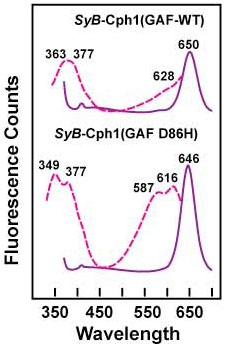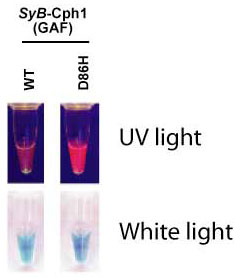Research Tools

Phytochrome-Based Fluorophores with Strong Fluorescence in the Red/Far-Red Region
WARF: P07413US
Inventors: Andrew Ulijasz, Junrui Zhang, Katrina Forest, David Anstrom, Jeremiah Wagner, Richard Vierstra
The Wisconsin Alumni Research Foundation (WARF) is seeking commercial partners interested in developing genetically-engineered, phytochrome-based reporter molecules with strong fluorescence.
Overview
Several fluorescent reporter molecules, such as the Green Fluorescent Protein (GFP), are available as research tools to monitor gene activity and protein distribution within cells. However, currently known reporter molecules have several limitations that restrict their use, including short wavelength of absorption and fluorescence emission, which prevents use in thick samples, and delayed development of fluorescence after expression. The discovery of novel molecules could provide additional tools for biotechnology.
Phytochromes are red/far-red light photoreceptors that direct photosensory responses in bacteria, fungi and plants. Although many phytochrome mutations have been identified via random mutagenesis screens, it would be useful if such mutations could be genetically engineered in a more predictable and logical manner to create new reporter molecules.
Phytochromes are red/far-red light photoreceptors that direct photosensory responses in bacteria, fungi and plants. Although many phytochrome mutations have been identified via random mutagenesis screens, it would be useful if such mutations could be genetically engineered in a more predictable and logical manner to create new reporter molecules.
The Invention
UW-Madison researchers have developed phytochrome-based fluorophores with strong fluorescence in the red/far-red region. These fluorophores provide new molecules that can be used to localize and monitor proteins of interest or detect gene expression in cells. In addition, because they absorb in the red/far-red region, these proteins can be used as reporters in thick samples, including whole mice and plants. The fluorophores also can be used in combination with molecules that fluoresce at lower wavelengths to detect multiple proteins at the same time.
Applications
- Tracking macromolecule movements in living cells, plants and animals
- High throughput detection of molecules in plate-based or chip assays
- Detection of protein:protein interactions in Fluorescence Resonance Energy Transfer (FRET)
- Nanotechnology applications, such as single molecule measurements of biomolecular motion
Key Benefits
- Modified phytochromes exhibit an unusually long wavelength of absorption (up to 700 nm) and fluorescence emission (up to 720 nm).
- These phytochromes can be used for both C- and N-terminal protein fusions, in contrast to other widely used fluorescent reporters, such as GFP.
- Fluorescence occurs only minutes after expression.
- Different fluorophores can be used to fine tune wavelengths to meet the needs of a specific system.
- Phytochromes from a variety of organisms can be used as starting points.
- These phytochromes do not require oxygen, unlike GFP, making them particularly useful for anaerobic applications.
- Thermotolerant phytochromes are capable of withstanding temperatures above 70 °C.
Additional Information
For More Information About the Inventors
Publications
- Wagner et al. 2008. Mutational Analysis of Deinococcus radiodurans Bacteriophytochrome Reveals Key Amino Acids Necessary for the Photochromicity and Proton Exchange Cycle of Phytochromes. J. Biol. Chem. 283, 12212-12226.
- Ulijasz et al. 2008. Characterization of Two Thermostable Cyanobacterial Phytochromes Reveals Global Movements in the Chromophore-Binding Domain During Photoconversion. J. Biol. Chem. 283, 21251-21266.
Tech Fields
For current licensing status, please contact Jennifer Gottwald at [javascript protected email address] or 608-960-9854
Figures

